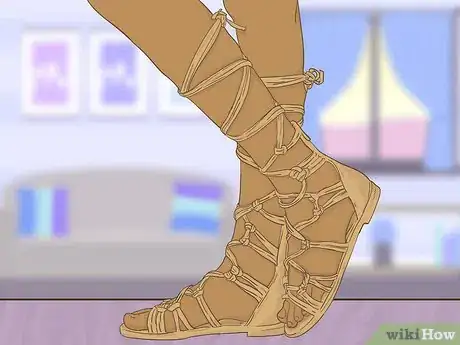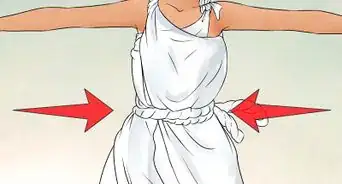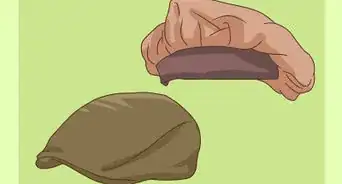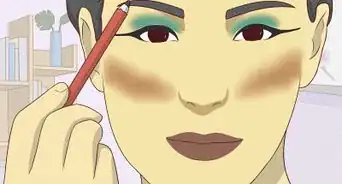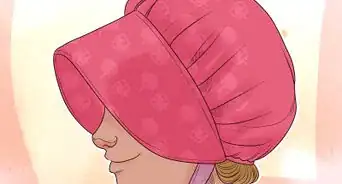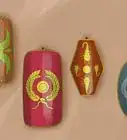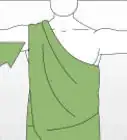This article was co-authored by Chloée Ohayon-Crosby. Chloée Ohayon-Crosby is a Costume Designer and Wardrobe Specialist in Los Angeles, California. With over eight years of experience in fashion consulting, Chloée specializes in personal, film, theater, and commercial styling as well as image consulting and costume design. Chloée has worked as an assistant designer for the distinguished fashion house Chloée and as a freelance stylist with Glamour Italia. Chloée studied Fine/Studio Arts at the Ecole Nationale Supérieure des Beaux-Arts and Fashion Design and Merchandising at the world renowned ESMOD École Supérieure des Arts in Paris, France.
This article has been viewed 138,840 times.
Want to wear a Roman toga as a costume or for another reason? Make sure you wear it the right way! Roman togas were very specific when it came to fabric type, color, and style.
Steps
Getting the Right Cloth
-
1Obtain a fine wool cloth. Roman togas were traditionally made out of wool. If you want to be completely authentic, start with a single piece of woolen cloth in the shape of a semicircle.
- Rich Romans chose the best forms of Italian wool, especially the wool from Apulia or Tarentum. The wool can be hot, but it helped the fabric stick together. Strive for between 5 and 6 yards. A child's toga should take only 4 yards (3.7 m). You will need a lot of cloth. The authentic toga is 18 feet (5.5 m) long and 12 feet high.[1]
- The toga originated from an Etruscan garment called the “tebenna.” The word toga comes from Latin “tegere,” which means “to cover.”[2] Only free men wore togas in ancient Rome; The basic female garment was a long tunic that reached to the ground and was called a stola. Children were more likely seen in belted tunics.
- Togas are meant to be worn loose as an outer garment without sleeves, open from the waist up. Typically, togas are draped around the body, with one edge on the left side of the body, and then wound around the back and beneath the right am. The loose end of cloth is thrown over the left shoulder.
-
2Wear white. In ancient Rome, regular togas were spotless white. The toga's white color was required by law.[3] Go to a fabric store. You can purchase fabric pretty cheaply.
- Some politicians used chalk to whiten their togas so they would stand out more. Candida means white, and candidates were called “the white ones.”
- If you don't choose white, try purple because that color denoted higher status in ancient Rome (usually indicated through a purple stripe on the toga). Sometimes black togas were worn during periods of mourning.
- Winning military commanders did occasionally wear brightly colored and embroidered togas. Ceremonial togas were fully purple or included the purple stripes. Kings, augurs, and some priests wore them. In ancient Rome, purple dye came from the glands of sea snails found in the Mediterranean. The purple stripe ran across the straight edge of the toga.
Advertisement -
3Use a bedsheet. If you don't have wool, you could try using a regular white bedsheet. Many people have gone this route for costume parties.
- A twin sized sheet can be too small and short. A King sheet might get too bulky. A full or Queen sheet is the best choice, in most cases, unless the toga is for a child or someone the size of one.
- Togas should look dignified. Romans considered it improper to be seen in public without a toga. Eventually the toga became formal wear seen in legal courts, the theater, or at the imperial court.
- Slaves, non-citizens, and women were not allowed to wear togas in ancient Rome.
Folding the Cloth into a Toga
-
1Fold the cloth in half. Make sure that you are folding it lengthwise. Fold the cloth just short of the halfway mark if you want the toga to drape longer across your body.
- Take one end of the toga, and drape it across your left shoulder. You will want to adjust the cloth so that its bottom lands above your left ankle.
- Hold the toga in place with the left arm and body. Wrap the cloth around your back. Stop when it reaches across the back to the right side of your body.
- When wrapping the cloth around your back, wrap about three feet of the fabric about 1.5 times around your waist.
-
2Create folds in the cloth. Take the rest of the cloth's width in hand, and create folds or ripples in it. Some describe this as an accordion-like texture.
- Wrap the cloth the rest of the way around your body, under your right arm and then across the body's front.
- Drape the remaining part over your left shoulder. This is the most important look of the toga: It must be draped over one shoulder, usually the left.
- Alternatively, bring both of the fabric ends up to one shoulder, and tie them. Then take the extra materials from the knot area, and fold it down under the rest of the fabric.
-
3Use the sheet instead. Folding a bedsheet into a toga is very similar, with the exception that the sheet is likely to be rectangular in shape instead of a semi-circle.
- Take a corner of the sheet in hand. Hold it in front of the top of your left shoulder. Drape it across the chest. Tuck it under your right arm.
- Wrap it around the back. Tuck it under the left arm and in front of your chest. Take the second corner. Bring it across your chest under your arm and around your back.
- Bring the corner up over your back. The toga should be about knee length. All you will need is bed sheet, some safety pins, and a decorative pin.
Accessorizing the Toga
-
1Secure the sheet on your left shoulder. You may want to use a safety pin to do this, but you could also use a decorate pin or brooch.
- Pin the brooch on the shoulder or chest. Or fasten the two ends of the cloth or sheet with a brooch, safety pin or knot. The brooch can be in any color, and could even contain bright jewels. Romans were not supposed to pin or sew their togas. If you use a more slippery fabric, though, you will have to do so or it will fall down.
- The woolen fabric of a traditional Roman toga did not have much stitching or sewing. There also weren't button holes.
- Finish off the look with a cord or rope belt. Usually, this belt should match the color of the toga, most commonly white.
-
2Wear the right undergarments. Only free Roman citizens could wear the toga. In the old days, togas were worn over naked bodies, but later they were worn over tunics and tied at the waist with a belt.
- Roman undergarments consisted of a simple loin cloth that was knotted on both sides. The undergarments had different names.
- Women also wore a band that was tightly tied across their bust. Undergarments were generally made of linen.
- As undergarments, it's best to wear a plain white T-shirt and white or flesh colored underwear. The Romans wore short-sleeved wool tunics under their togas.[4] [5]
-
3Wear the right footwear. You're not going to look very authentic if you pair your Roman toga with a pair of high heels or sneakers!
- Roman men wore leather boots or sandals. The boots were designed to outlast the rigors of marching, and the sandals were commonly worn for comfort in the summer. You can find Roman sandals or boots for purchase on many sites online.
- Roman sandals typically had lacing up the calf. Leather cords or braids attached the sole of the sandal to the leg. There were many different kinds of sandals.[6]
- Roman shoes were generally made out of leather and sometimes out of pigskin. Romans who were very wealthy or high in status would dye their sandals red. You could carry a shield. Some people have used hub caps!
Community Q&A
-
QuestionDo I have to put on footwear?
 Community AnswerNo, footwear is not necessary. However, many noble-people of the Roman empire wore sandals to complete their outfits.
Community AnswerNo, footwear is not necessary. However, many noble-people of the Roman empire wore sandals to complete their outfits. -
QuestionShould you wear jewelry with a toga?
 Community AnswerOther than a brooch to hold up the toga, not a lot. It was considered bad manners in ancient Rome to wear more than one ring.
Community AnswerOther than a brooch to hold up the toga, not a lot. It was considered bad manners in ancient Rome to wear more than one ring. -
QuestionCan I use a heavier blanket instead?
 Community AnswerYou can try, but keep in mind that your toga will be warmer and more difficult to move around in. The drape and final look might also be different.
Community AnswerYou can try, but keep in mind that your toga will be warmer and more difficult to move around in. The drape and final look might also be different.
References
- ↑ https://www.youtube.com/watch?v=BQYloC_QcWY
- ↑ http://www.tribunesandtriumphs.org/roman-clothing/how-to-make-a-toga.htm
- ↑ http://www.fashion-era.com/ancient_costume/roman-costume-history-toga.htm
- ↑ http://blogs.getty.edu/iris/how-to-wear-a-toga-the-ancient-roman-way/
- ↑ https://www.youtube.com/watch?v=BQYloC_QcWY
- ↑ http://www.tribunesandtriumphs.org/roman-clothing/roman-sandals-and-boots.htm








